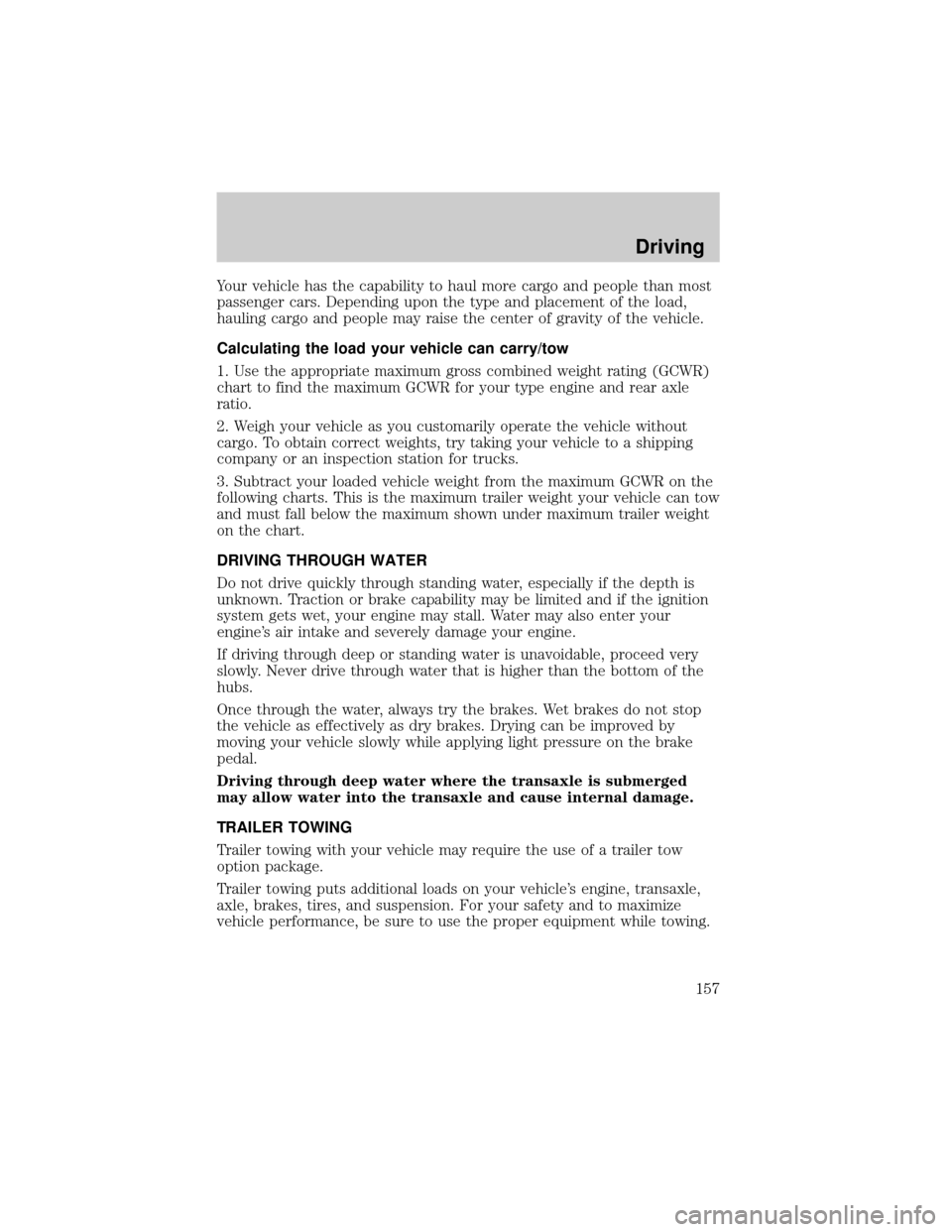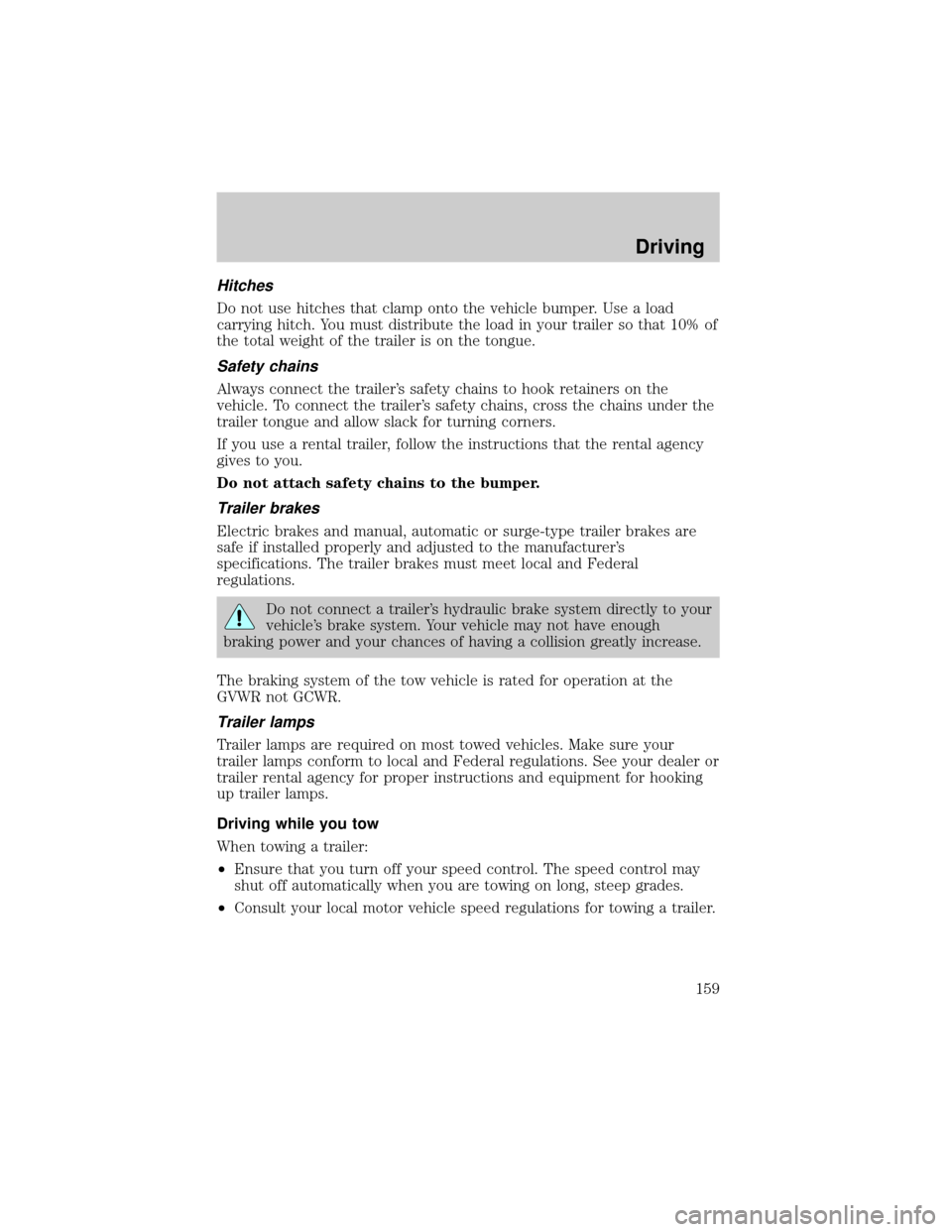2001 FORD ESCAPE brakes
[x] Cancel search: brakesPage 157 of 280

Your vehicle has the capability to haul more cargo and people than most
passenger cars. Depending upon the type and placement of the load,
hauling cargo and people may raise the center of gravity of the vehicle.
Calculating the load your vehicle can carry/tow
1. Use the appropriate maximum gross combined weight rating (GCWR)
chart to find the maximum GCWR for your type engine and rear axle
ratio.
2. Weigh your vehicle as you customarily operate the vehicle without
cargo. To obtain correct weights, try taking your vehicle to a shipping
company or an inspection station for trucks.
3. Subtract your loaded vehicle weight from the maximum GCWR on the
following charts. This is the maximum trailer weight your vehicle can tow
and must fall below the maximum shown under maximum trailer weight
on the chart.
DRIVING THROUGH WATER
Do not drive quickly through standing water, especially if the depth is
unknown. Traction or brake capability may be limited and if the ignition
system gets wet, your engine may stall. Water may also enter your
engine's air intake and severely damage your engine.
If driving through deep or standing water is unavoidable, proceed very
slowly. Never drive through water that is higher than the bottom of the
hubs.
Once through the water, always try the brakes. Wet brakes do not stop
the vehicle as effectively as dry brakes. Drying can be improved by
moving your vehicle slowly while applying light pressure on the brake
pedal.
Driving through deep water where the transaxle is submerged
may allow water into the transaxle and cause internal damage.
TRAILER TOWING
Trailer towing with your vehicle may require the use of a trailer tow
option package.
Trailer towing puts additional loads on your vehicle's engine, transaxle,
axle, brakes, tires, and suspension. For your safety and to maximize
vehicle performance, be sure to use the proper equipment while towing.
Driving
157
Page 159 of 280

Hitches
Do not use hitches that clamp onto the vehicle bumper. Use a load
carrying hitch. You must distribute the load in your trailer so that 10% of
the total weight of the trailer is on the tongue.
Safety chains
Always connect the trailer's safety chains to hook retainers on the
vehicle. To connect the trailer's safety chains, cross the chains under the
trailer tongue and allow slack for turning corners.
If you use a rental trailer, follow the instructions that the rental agency
gives to you.
Do not attach safety chains to the bumper.
Trailer brakes
Electric brakes and manual, automatic or surge-type trailer brakes are
safe if installed properly and adjusted to the manufacturer's
specifications. The trailer brakes must meet local and Federal
regulations.
Do not connect a trailer's hydraulic brake system directly to your
vehicle's brake system. Your vehicle may not have enough
braking power and your chances of having a collision greatly increase.
The braking system of the tow vehicle is rated for operation at the
GVWR not GCWR.
Trailer lamps
Trailer lamps are required on most towed vehicles. Make sure your
trailer lamps conform to local and Federal regulations. See your dealer or
trailer rental agency for proper instructions and equipment for hooking
up trailer lamps.
Driving while you tow
When towing a trailer:
²Ensure that you turn off your speed control. The speed control may
shut off automatically when you are towing on long, steep grades.
²Consult your local motor vehicle speed regulations for towing a trailer.
Driving
159
Page 205 of 280

BRAKE FLUID
Checking and adding brake fluid
Brake fluid should be checked and
refilled as needed. Refer to the
scheduled maintenance guide for
the service interval schedules.
1. Clean the reservoir cap before
removal to prevent dirt or water
from entering the reservoir.
2. Visually inspect the fluid level.
3. If necessary, add brake fluid from
a clean un-opened container until
the level reaches MAX. Do not fill
above this line.
4. Use only brake fluids certified to
meet Ford specification
ESA-M6C25±A. Refer toLubricant
specificationsin theCapacities
and specificationschapter.DOT 3 fluid is recommended. However,
if DOT 3 is not available, DOT 4 fluid can be used.
Brake fluid is toxic. If brake fluid contacts the eyes, flush eyes
with running water for 15 minutes. Seek medical attention if
irritation persists. If taken internally, drink water and induce vomiting.
Seek medical attention immediately.
If you use DOT 5 or any other brake fluid that is not DOT 3 or
DOT 4, you will cause permanent damage to your brakes.
Do not let the fluid level in the reservoir for the master cylinder
fall below the MIN mark. If master cylinder runs dry, this may
cause the brakes to fail.
Maintenance and care
205
Page 242 of 280

Washing your vehicle
Wash your vehicle regularly with
cold or lukewarm water. Never use
strong detergents or soap. If your
vehicle is particularly dirty, use a
quality car wash detergent. Always
use a clean sponge, washing glove
or similar device and plenty of water
for best results. To avoid spots,
avoid washing when the hood is still
warm, immediately after or during
exposure to strong sunlight.
During winter months, it is especially important to wash the vehicle on a
regular basis. Large quantities of dirt and road salt are difficult to
remove and also cause damage to the vehicle.
Any gasoline spilled on the vehicle or deposits such as bird droppings
should be washed and sponged off as soon as possible. Deposits not
removed promptly can cause damage to the vehicle's paintwork.
Remove any exterior accessories, such as antennas, before entering a car
wash. If you have wax applied to the vehicle at a commercial car wash, it
is recommended that you clean the wiper blades and windshield as
described inCleaning the wiper blades and windshield.
After washing, apply the brakes several times to dry them.
Underbody
Flush the complete underside of vehicle frequently. Keep body drain
holes unplugged. Inspect for road damage.
Waxing your vehicle
Waxing your vehicle on a regular basis will reduce minor scratches and
paint damage.
Wax when water stops beading on the surface. This could be every three
or four months, depending on operating conditions.
Use only carnauba or synthetic-based waxes. Use a cleaning fluid with a
clean cloth to remove any bugs before waxing your vehicle. Use tar
remover to remove any tar spots.
Maintenance and care
242
Page 270 of 280

A
Air bag supplemental restraint
system ........................118±119, 124
and child safety seats ............121
description ......................119, 124
disposal ....................................127
driver air bag ..................121, 125
indicator light ...........11, 123, 126
operation .........................121, 125
passenger air bag ...........121, 125
side air bag ..............................124
Air cleaner filter ...............207, 247
Air conditioning ..........................21
All Wheel Drive (AWD),
driving off road ...................20, 150
Ambulance packages ....................5
Antifreeze (see Engine
coolant) .....................................208
Anti-lock brake system (see
Brakes) ..............................142±143
Anti-theft system ........................95
arming the system ....................96
disarming a triggered system ..96
warning light .............................13
Audio system (see Radio) ...26, 54
Automatic transaxle .................146
driving with .............................147
fluid, adding ............................214
fluid, checking ........................214
Automatic transmission
fluid, refill capacities ..............247
fluid, specification ..................252
Auxiliary power point .................85
Axle
lubricant specifications ..250, 252
refill capacities ........................247B
Battery .......................................216
acid, treating emergencies .....216
charging system warning light 13
jumping a disabled battery ....188
maintenance-free ....................216
replacement, specifications ...247
servicing ..................................216
Belt minder ...............................113
Brakes ........................................142
anti-lock ...........................142±143
anti-lock brake system (ABS)
warning light .....................12, 142
brake warning light ..................12
fluid, checking and adding ....205
fluid, refill capacities ..............247
fluid, specifications .........250, 252
lubricant specifications ..250, 252
parking ....................................143
shift interlock ..........................146
Break-in period .............................3
C
Capacities for refilling fluids ....247
Cargo cover .................................86
Cargo net .....................................86
Certification Label ....................254
Child safety restraints ..............127
child safety belts ....................127
Child safety seats ......................128
attaching with tether straps ..132
in front seat ............................129
in rear seat ..............................129
LATCH .....................................134
Cleaning your vehicle ...............241
engine compartment ..............243
Index
270
Page 273 of 280

Headlamps ...................................81
aiming ......................................240
bulb specifications ..................239
daytime running lights .............81
flash to pass ..............................82
high beam ...........................13, 81
replacing bulbs .......................235
turning on and off ....................81
warning chime ..........................15
Heating ........................................21
heater only system ...................21
heating and air conditioning
system .......................................22
Hood ..........................................197
I
Ignition .................................71, 252
Infant seats
(see Safety seats) .....................128
Inspection/maintenance (I/M)
testing ........................................234
Instrument panel
cleaning ...................................245
cluster ................................10, 246
lighting up panel and
interior .......................................19
location of components ............10
J
Jack ............................................183
positioning ...............................183
storage .....................................183
Jump-starting your vehicle ......188K
Keys .......................................93±94
key in ignition chime ...............15
positions of the ignition ...........71
L
Lamps
bulb replacement
specifications chart ................239
cargo lamps ...............................19
daytime running light ...............81
fog lamps ...................................82
headlamps .................................81
headlamps, flash to pass ..........82
instrument panel, dimming .....19
interior lamps .............79±80, 239
replacing bulbs .......235, 237±239
Lane change indicator (see
Turn signal) .................................71
Liftgate ........................................89
Lights, warning and indicator ....10
air bag ........................................11
anti-lock brakes (ABS) ....12, 142
anti-theft ...................................13
brake ..........................................12
charging system ........................13
cruise indicator .........................13
door ajar ....................................14
fuel cap light .............................15
high beam .................................13
low coolant ................................14
low fuel ......................................11
oil pressure ...............................13
overdrive off ..............................14
safety belt .................................12
service engine soon ..................10
turn signal indicator .................12
Index
273